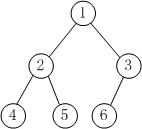
先序遍历为:1 2 4 5 3 6,中序遍历为:4 2 5 1 6 3
思路:
先序遍历的第一个元素为根节点,在中序遍历中找到这个根节点,从而可以将中序遍历分为左右两个部分,左边部分为左子树的中序遍历,右边部分为右子树的中序遍历,进而也可以将先序遍历除第一个元素以外的剩余部分分为两个部分,第一个部分为左子树的先序遍历,第二个部分为右子树的先序遍历。
由上述分析结果,可以递归调用构建函数,根据左子树、右子树的先序、中序遍历重建左、右子树。
代码:
1 |
|
重建二叉树后后序遍历的结果如下:

先序遍历为:1 2 4 5 3 6,中序遍历为:4 2 5 1 6 3
先序遍历的第一个元素为根节点,在中序遍历中找到这个根节点,从而可以将中序遍历分为左右两个部分,左边部分为左子树的中序遍历,右边部分为右子树的中序遍历,进而也可以将先序遍历除第一个元素以外的剩余部分分为两个部分,第一个部分为左子树的先序遍历,第二个部分为右子树的先序遍历。
由上述分析结果,可以递归调用构建函数,根据左子树、右子树的先序、中序遍历重建左、右子树。
1 | #include <stdlib.h> |
重建二叉树后后序遍历的结果如下: